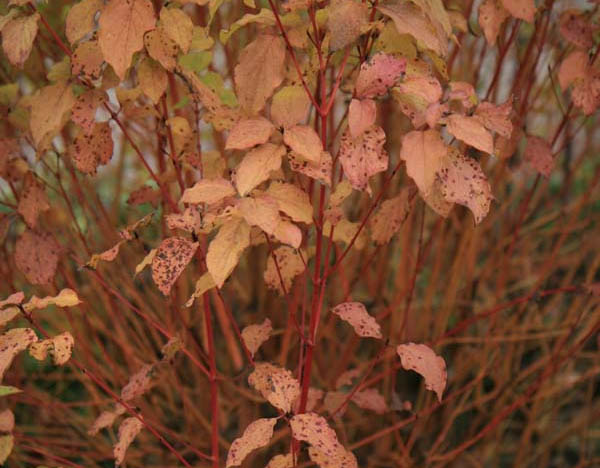
Submitted by Susan Hamilton, Director of the University of Tennessee Gardens
Cornussanguinea ‘Midwinter Fire’, commonly called bloodtwig dogwood, is a hard plant to beat for colorful show in the winter landscape. I have four different cultivars of this great winter-interest dogwood species in my home landscape, but Midwinter Fire is my favorite. I have my specimen planted with an evergreen holly with red berries behind it. In the winter as I view it from my kitchen window, its colorful stems pop against the dark green holly foliage.
Midwinter Fire is a multi-stemmed, suckering, deciduous shrub that grows to 5 feet tall and 6 feet wide. The standout features of this selection include golden fall foliage followed by branches and stems that start out yellow in color at the base of the plant and gradually turn bright orange to red towards the tip of the plant. Small white flowers similar to Queen Anne’s Lace appear in late spring. The flowers give way to clusters of dark purple berries in summer that are good for attracting birds. No insect or disease problems are common.
This shrub-type dogwood is tolerant of a variety of soil types from dry, well-drained soil to consistently moist, bog-like conditions. The root suckers freely to form a dense colony, but it can easily be root pruned if suckers are not desired. It thrives in full-sun to partial-shade, and pruning is not required. However, the best winter stem color occurs on young, new growth. Many gardeners prune back all stems to about one foot in late winter each year to rejuvenate the shrub and promote the best winter stem color the following year. Another pruning option is to remove one quarter to one third of the oldest stems in early spring each year promoting new, colorful branches for winter show. Any loss of flowers through spring pruning is not significant since the small flowers of this dogwood are not showy or really noticeable.
Bloodtwig dogwood should be planted where its colorful branches can be enjoyed during the winter. For a striking display, plant it massed in groups of three or more. This plant is also ideal for pairing in a shrub border with colorful conifers that are dark green, blue, or yellow to contrast against Midwinter Fire’s stems. The cultivar is also nice when paired with hollies loaded with complementary colored berries. Susan Hamilton is on the faculty in the University of Tennessee Department of Plant Sciences and also serves as Director of the UT Gardens. The University of Tennessee Gardens located in Knoxville and Jackson are part of the UT Institute of Agriculture. Their mission is to foster appreciation, education and stewardship of plants through garden displays, collections, educational programs and research trials. The gardens are open during all seasons and free to the public. See http://utgardens.tennessee.edu/ and http://westtennessee.tennessee.edu/ornamentals/ for more information.
Contacts:
Dr. Susan Hamilton, Director of the UT Gardens, 865-974-7324
Patricia McDaniels, UTIA Marketing and Communications Services, 615-835-457